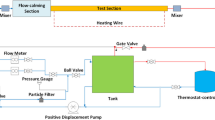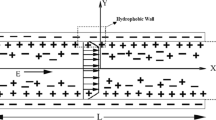Abstract
In the present study, the effects of wall roughness on the dynamic of laminar electro-osmotic flow (EOF) between two parallel plates have been investigated numerically. The governing equations of the flow in a system of two-dimensional general coordinates are solved using the finite-volume numerical method in a non-uniform grid with the maximum orthogonality of the grid lines adjacent to the rough boundaries. In the first step, the surface ruggednesses of the wall are divided into two categories: “surface roughness” and “wall blocks”. The wall surface ruggednesses have profiles in the forms of sinuses, saw teeth, and square teeth. Then, the distinction boundary of surface roughness from wall blocks is determined as \({\left.\mathrm{h}/\mathrm{H}\right|}_{cr}=0.078\) by defining and applying two qualitative and quantitative criteria. Finally, the dynamic of EOF near the walls surface roughness with \(0.001\le\upvarepsilon /\mathrm{H}\le 0.05\) is investigated. According to the results, unlike macro-scale pressure-driven flows, the effect of surface roughness is not only non-negligible on the laminar EOF through the microchannels but also disruptive for the ionic and dynamic development of the flow adjacent to the walls. Finally, based on the numerical results, a new correlation has been developed for variations of \(\dot{\mathrm{m}}\) for laminar EOF between two parallel plates in the presence of the surface roughness and its maximum error is 2%.


















Similar content being viewed by others
Notes
Arithmetical mean deviation of the assessed profile (\(Ra=\frac{1}{n}\sum_{i=1}^{n}\left|{y}_{i}\right|\)).
Abbreviations
- \(A\) :
-
A dimensionless parameter, representing the ratio of the external applied voltage to the base voltage
- \(B\) :
-
A dimensionless parameter, representing the ratio of ionic pressure to dynamic pressure
- \(D^{ \pm }\) :
-
Positive and negative ion diffusion coefficients (m2/s)
- \(E\) :
-
External electric field strength (V/m)
- \(e\) :
-
Elementary charge of an electron (C)
- \(F\) :
-
Force (N)
- \(H\) :
-
Microchannel height (m)
- \(h\) :
-
Height of the surface ruggedness (m)
- \(i,j\) :
-
Node number in \(\xi\) and \(\eta\) direction
- \(\hat{i}, \hat{j}\) :
-
Unit vectors in x and y directions
- \(K\) :
-
Debye-Huckel parameter (1/m)
- \(k_{b}\) :
-
Boltzmann constant (J/K)
- \(L\) :
-
Microchannel length (m)
- \(L_{L} , L_{M} , L_{R}\) :
-
Inlet, Middle and Outlet region length (m)
- \(\dot{m}\) :
-
Mass flow rate per unit depth of channel (kg/s)
- \(n\) :
-
Perpendicular to the wall of the microchannel
- \(n_{0}\) :
-
Bulk concentration of ions in the electrolyte solution per unit volume (ions/m3)
- \(n^{ \pm }\) :
-
Concentration of positive and negative ions (ions/m3)
- \(p\) :
-
Pressure (Pa)
- \(Re\) :
-
Reynolds number
- \(Sc^{ \pm }\) :
-
Schmidt number of ions
- \(T\) :
-
Absolute temperature (K)
- \(u, v\) :
-
X- and y-component of velocity (m/s)
- \(\forall\) :
-
Volume of a computational cell (m3)
- \(V_{app}\) :
-
External applied voltage (V)
- \(x, y\) :
-
Cartesian coordinates
- \(z\) :
-
Charge valence number
- \(\varepsilon\) :
-
Height of the surface roughness (m)
- \(\varepsilon_{0}\) :
-
Vacuum permittivity (C/V m)
- \(\varepsilon_{r}\) :
-
Relative permittivity
- \(\zeta\) :
-
Wall zeta potential (V)
- \(\eta , \xi\) :
-
Perpendicular and Tangential directions of the body-fitted coordinate
- \(\kappa\) :
-
Double-layer thickness parameter
- \(\mu\) :
-
Fluid dynamic viscosity (Pa s)
- \(\rho\) :
-
Fluid density (kg/m3)
- \(\rho _{e}\) :
-
Net electric charge density (C/m3)
- \(\varphi\) :
-
External electric potential field (V)
- \(\psi\) :
-
Electric potential field in EDL (V)
- \(1, 2\) :
-
At the inlet and outlet
- \(cr\) :
-
Critical value
- \(e, w, n, s\) :
-
The eastern, western, northern and southern facets of the control volume
- \(i, j\) :
-
Node number in \(\xi\) and \(\eta\) direction
- \(in\) :
-
Inlet
- \(N\) :
-
Normal
- \(ref\) :
-
Reference value
- \(S\) :
-
Shear
- \(x, y\) :
-
Cartesian coordinates
- \(\overline{\,\,}\) :
-
Bar, for dimensionless parameter
References
Mirbozorgi S, Niazmand H, Renksizbulut M (2006) Electro-osmotic flow in reservoir-connected flat microchannels with non-uniform zeta potential. J Fluids Eng 128(6):1133–1143
Black JT (2019) Degarmo’s materials and processes in manufacturing, 13th edn. Wiley, Hoboken
Natrajan V, Christensen K (2010) The impact of surface roughness on flow through a rectangular microchannel from the laminar to turbulent regimes. Microfluid Nanofluid 9(1):95–121
Gamrat G, Favre-Marinet M, Le Person S, Baviere R, Ayela F (2008) An experimental study and modelling of roughness effects on laminar flow in microchannels. J Fluid Mech 594:399–423
Hu Y, Werner C, Li D (2003) Influence of three-dimensional roughness on pressure-driven flow through microchannels. J Fluids Eng 125(5):871–879
Papautsky I, Brazzle J, Ameel T, Frazier AB (1999) Laminar fluid behavior in microchannels using micropolar fluid theory. Sens Actuators A 73(1–2):101–108
Park HS, Punch J (2008) Friction factor and heat transfer in multiple microchannels with uniform flow distribution. Int J Heat Mass Transf 51(17–18):4535–4543
Yang S, Yu B, Zou M, Liang M (2014) A fractal analysis of laminar flow resistance in roughened microchannels. Int J Heat Mass Transf 77:208–217
Dharaiya V, Kandlikar S (2013) A numerical study on the effects of 2D structured sinusoidal elements on fluid flow and heat transfer at microscale. Int J Heat Mass Transf 57(1):190–201
Croce G, D’agaro P, Nonino C (2007) Three-dimensional roughness effect on microchannel heat transfer and pressure drop. Int J Heat Mass Transf 50(25–26):5249–5259
Qi C, Ng C-O (2018a) Electroosmotic flow of a two-layer fluid in a slit channel with gradually varying wall shape and zeta potential. Int J Heat Mass Transf 119:52–64
Keramati H, Sadeghi A, Saidi MH, Chakraborty S (2016) Analytical solutions for thermo-fluidic transport in electroosmotic flow through rough microtubes. Int J Heat Mass Transf 92:244–251
Park H, Lee H (2012) Effects of wall roughness and velocity slip on streaming potential of microchannels. Int J Heat Mass Transf 55(11):3295–3306
Qi C, Ng C-O (2018b) Rotating electroosmotic flow in a non-uniform microchannel. Meccanica 53(8):2105–2120
Ajdari A (1995) Electro-osmosis on inhomogeneously charged surfaces. Phys Rev Lett 75(4):755
Cho C-C (2007) Electrokinetically-driven flow mixing in microchannels with wavy surface. J Colloid Interface Sci 312(2):470–480
Yang D, Liu Y (2008a) Numerical simulation of electroosmotic flow in microchannels with sinusoidal roughness. Colloids Surf A 328(1):28–33
Yang D, Liu Y (2008b) Numerical simulation of electroosmotic flow in microchannels with rough surface. J Chem Ind Eng (China) 10:029
Kang S, Suh YK (2009) Electroosmotic flows in an electric double layer overlapped channel with rectangle-waved surface roughness. Microfluid Nanofluid 7(3):337–352
Cho C-C, Chen C-L (2012) Mixing enhancement of electrokinetically-driven non-Newtonian fluids in microchannel with patterned blocks. Chem Eng J 191:132–140
Yau H-T, Wang C-C, Cho C-C, Co-K C (2011) A numerical investigation into electroosmotic flow in microchannels with complex wavy surfaces. Therm Sci 15(5):87
Cho C-C (2013) Numerical investigation into mixing performance of electrokinetically-driven power-law fluids in microchannel with patterned trapezoid Blocks. In: Proceedings of world academy of science, engineering and technology, 2013, vol 79. World Academy of Science, Engineering and Technology (WASET), p 780
Yoshida H, Kinjo T, Washizu H (2016) Analysis of electro-osmotic flow in a microchannel with undulated surfaces. Comput Fluids 124:237–245
Haynes WM (2014) CRC handbook of chemistry and physics. CRC Press, Cambridge
Farrashkhalvat M, Miles J (2003) Basic structured grid generation: with an introduction to unstructured grid generation. Elsevier, New York
Hoffmann KA, Chiang ST (1993) Computational fluid dynamics for engineers, vol 1. Engineering Education System, Wichita
Sørli K (1997) Generation of structured adaptive grids using elliptic partial differential equations and control functions. Issue: STF42 A97503. SINTEF, Trondheim, Norway
Panton RL (2013) Incompressible flow, 4th edn. Wiley, Hoboken
Author information
Authors and Affiliations
Corresponding author
Ethics declarations
Conflict of interest
The authors declare that they have no conflict of interest.
Additional information
Publisher's Note
Springer Nature remains neutral with regard to jurisdictional claims in published maps and institutional affiliations.
Rights and permissions
About this article
Cite this article
Fakhari, M.M., Mirbozorgi, S.A. Numerical analysis of the effects of roughness on the electro-osmotic laminar flow between two parallel plates. Meccanica 56, 1025–1045 (2021). https://doi.org/10.1007/s11012-020-01257-4
Received:
Accepted:
Published:
Issue Date:
DOI: https://doi.org/10.1007/s11012-020-01257-4




